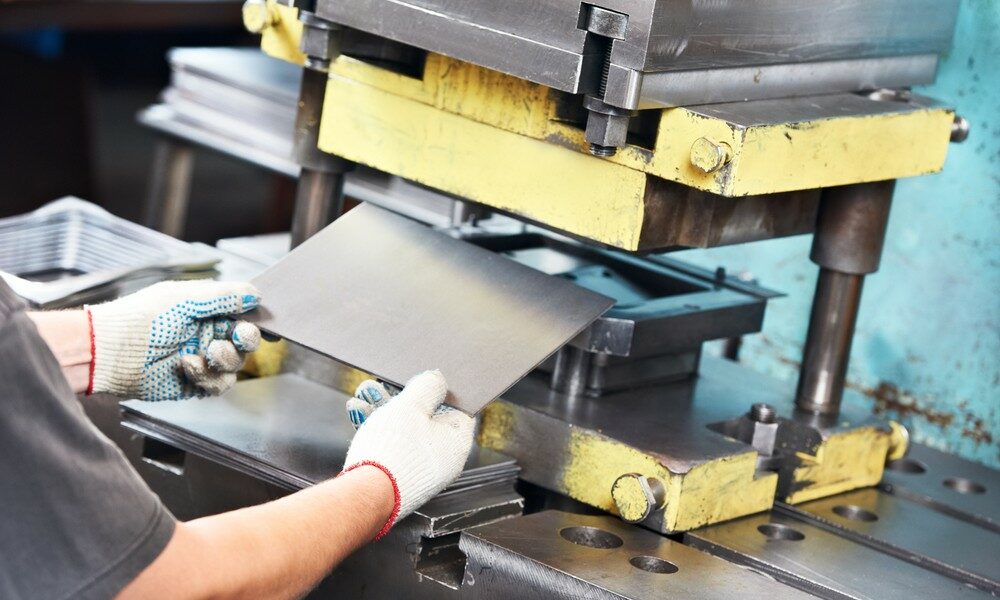Why Metal Stamping is Essential for Creating Sturdy and Complicated Parts
Why Metal Stamping is Essential for Creating Sturdy and Complicated Parts
Blog Article
Advanced Techniques in Metal Stamping for Precision Production
As markets consistently demand finer resistances and detailed designs in their steel parts, the pursuit for advanced methods in steel marking has actually increased. From the application of sophisticated multi-stage marking procedures to the integration of cutting-edge automation innovations, the landscape of steel marking is undergoing a profound change.
Advanced Multi-Stage Stamping Procedures
Going over the ins and outs of sophisticated multi-stage stamping processes discloses the innovative methods employed in contemporary manufacturing methods. Metal Stamping. Multi-stage stamping is an intricate process that includes several steps to change a flat sheet of metal right into a final stamped product. The usage of progressive passes away, where different operations are done at each stage of the marking process, allows for high accuracy and performance in the manufacturing of complex metal components
Throughout the initial stages of multi-stage marking, the level steel sheet is fed into the marking press, where a collection of passes away are utilized to reduce and form the material. Subsequent stages entail added creating, flexing, and punching procedures to more improve the component. Each phase is thoroughly developed to build on the previous one, causing the production of complicated geometries with limited tolerances.
Advanced multi-stage marking processes require a high level of competence and accuracy to make certain the top quality and consistency of the stamped components. By using innovative equipment and tooling, suppliers can create a large range of steel components with effectiveness and accuracy.
Accuracy Tooling Innovations
Accuracy tooling developments have actually revolutionized the steel stamping sector, boosting performance and top quality in manufacturing procedures. CNC systems permit for complex designs to be equated straight into tooling, making sure accuracy and repeatability in the marking process.
In addition, the integration of sensors and real-time surveillance capabilities in accuracy tooling has actually enabled producers to detect and resolve concerns promptly, decreasing downtime and minimizing scrap prices. By including clever innovation right into tooling, drivers can enhance parameters such as stress, speed, and alignment throughout the stamping procedure, leading to enhanced product quality and raised performance.

Automation in Steel Stamping
The advancement of precision tooling developments in the steel marking sector has actually led the way for considerable innovations in automation, transforming the production landscape in the direction of raised performance and performance. Metal Stamping. Automation in steel stamping involves the use of innovative equipment and robotics to execute different jobs commonly carried out by human drivers. This shift in the direction of automation provides various benefits, including enhanced accuracy, faster production cycles, and decreased labor expenses
One trick element of automation in steel marking is the implementation of computer system numerical control (CNC) systems, which make it possible for accurate control over the stamping procedure. CNC technology enables for the production of complicated and intricate metal get rid of regular quality. Additionally, automated systems can be programmed to run continually, causing higher output rates and much shorter lead times.
Furthermore, automation enhances work environment safety and security by decreasing hands-on handling of hefty materials and decreasing the threat of accidents (Metal Stamping). As making industries remain to welcome automation, the future of steel stamping holds excellent guarantee for also higher effectiveness and innovation
High-Speed Stamping Strategies

One of the primary benefits of high-speed stamping techniques is the ability to produce a large volume of components in a shorter amount of time contrasted to conventional marking approaches. This enhanced efficiency not just enables makers to meet limited production due dates but additionally enables cost savings with economic climates of range. Furthermore, high-speed marking can help in reducing material waste by optimizing the product usage during the marking procedure.
Furthermore, high-speed marking strategies commonly incorporate innovative features such as fast die adjustment systems and real-time surveillance abilities, even more improving the overall performance and versatility of the steel stamping process. As technology continues to development, high-speed stamping is anticipated to play an important function in driving the future of precision manufacturing.
High Quality Control in Stamping Workflow
Efficient quality assurance measures are crucial for guaranteeing the dependability and consistency of steel marking procedures. Quality assurance helpful resources in marking operations involves a series of systematic procedures targeted at spotting and avoiding flaws in the manufactured elements. One important element of high quality control in steel stamping is making use of advanced assessment methods such as optical inspection systems and coordinate determining devices (CMMs) to verify the click here for more info measurements and resistances of stamped components.
Furthermore, top quality control measures in stamping operations usually include the execution of statistical process control (SPC) techniques to monitor the production process in real-time and make sure that it stays within appropriate limits. By analyzing data and recognizing trends, makers can proactively resolve any variances from the wanted top quality requirements.
Moreover, quality control in metal stamping operations additionally entails comprehensive product screening to ensure that the raw materials used satisfy the needed requirements for the marking process. This may include carrying out material firmness tests, tensile stamina examinations, and dimensional inspections to guarantee the quality and integrity of the stamped components. In general, carrying that site out robust quality assurance actions is crucial for achieving high-quality stamped parts consistently.
Conclusion
In conclusion, progressed methods in steel marking play an essential duty in accuracy manufacturing processes. Through multi-stage marking procedures, cutting-edge tooling solutions, automation, high-speed methods, and strenuous top quality control procedures, producers can accomplish higher levels of precision and effectiveness in their procedures. These advancements in steel stamping technology have actually enabled companies to generate complex parts with limited tolerances, inevitably leading to enhanced product quality and consumer complete satisfaction in the production market.
Report this page